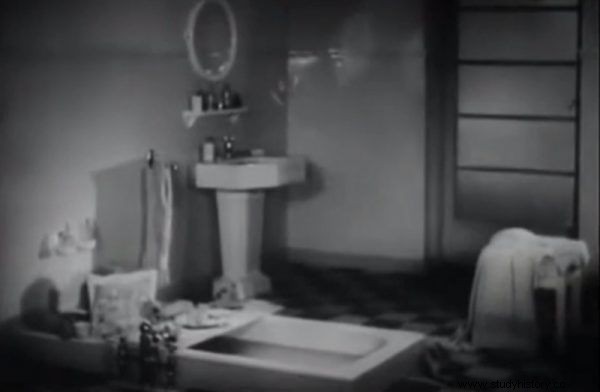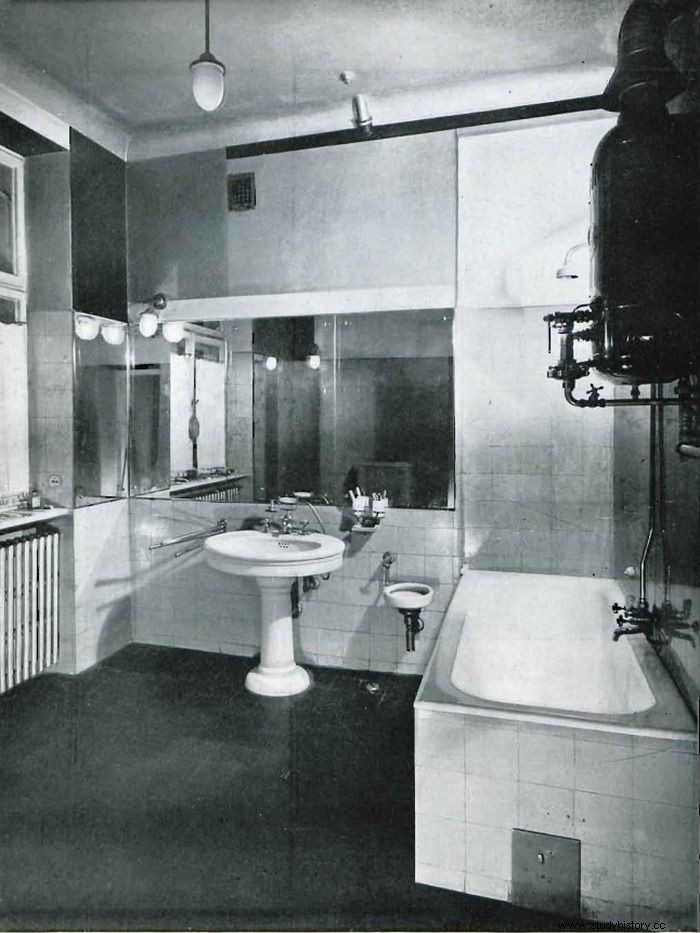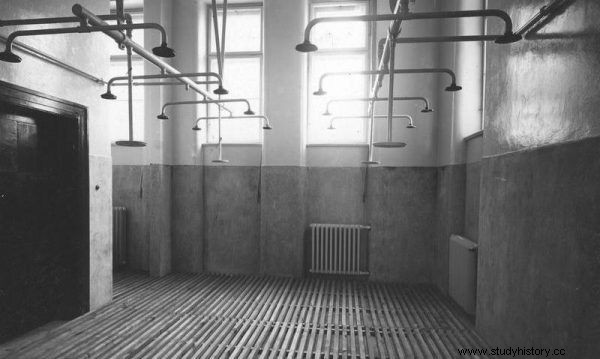A bathtub full of fragrant foam, a shower or a bowl of cold water? Before the war, there was no single idea for a bathroom. And many things that were obvious to us were simply considered luxury and extravagance.
On the screen, reality is always more colorful, especially when we watch ... a black and white pre-war film. These paintings are a treasury of knowledge about the past era, thanks to them we can get to know the then fashion, customs, language and visit the homes of our ancestors.
In the film "Two Joasie" from 1935, we admire not only the elegant office of patron Rostalski, decorated in the art deco style, but also the luxurious bathroom of his mistress, played by Ina Benita.
In one of the scenes, the most famous pre-war femme fatale takes a bath and at the same time browses a social chronicle, talks on the phone and drinks coffee . The bathroom presented in the comedy is almost a bathing salon, a luxury that only wealthy residents of large cities could afford. And how was it in ordinary houses?
Bathtub… for dirty pants
Bathrooms, as separate rooms, equipped with a bathtub connected to the water supply, appeared at the end of the 19th century. In Warsaw, the construction of a modern sewage system and water supply was initiated by President Sokrates Starynkiewicz. Wiliam Lindley, in turn, was responsible for the network's projects. However, the fashion for running water was met with some reluctance.

Miss Flora enjoys a bath in her luxurious bathroom (source:still from the movie "Two Joas").
At the beginning of the 20th century, the number of bathrooms in Warsaw homes was estimated at around 10,000. The Department of Folk Hygiene in a report published in the "Kurier Warszawski" in January 1900 stated that in many homes the bathtub serves as a place to fold dirty linen or unnecessary things. Bathtubs in municipal bathing establishments were more popular, which were used by over a quarter of a million people annually.
Thus, the statistics indicated that one resident of Warsaw had access to a bathtub once in 28 months. In the poorer spheres, an aversion to bathing was even stated. On the other hand, cheap hygiene centers were used most often by soldiers, and it was written about women that they were not friends of water.
Provision, washrooms and bathing salons
The situation began to change only in times of free Poland. The development of the water supply and sewage systems in the 1920s and 1930s enabled Poles to have access to running water, and therefore many homes were provided with places for personal hygiene. Depending on the technical conditions of the building, free space and the wealth of residents, the so-called makeshift facilities, washrooms, rooms or bathing salons.
An obligatory element of a modern bathroom from the interwar period was, of course, a bathtub, preferably acid-resistant. In addition to it, the room also included:a bathtub for children (in the form of a basin with a volume of 12-15 liters), a bidet, an English toilet (with a hatch), a bath stove and a washbasin.
The tenant who wanted comfort could also install canalised spittoons for brushing teeth and gas heaters for hair irons. The walls of the room were tiled, which made it easier to keep the bathroom clean.
A tap in every home!
Any shelves mounted above the washbasin, where you could keep toiletries, were also practical. For the owner's convenience, the wash basin could be double. In 1931 the cost of a basic bathroom device, i.e. without a bidet, spittoon bowl and glass shelf, oscillated around PLN 940. The salary of a better-endowed worker was then around 200 zlotys. So it was actually… even cheaper than today!

In the interwar period, a modern bathroom could not do without a bathtub and tiled walls (source:public domain).
In the magazine "Interior" from 1933 there was a photo of a very modern bathroom, for those times, designed by famous architects - Lucjanan Korngold and Henryk Blum. The spacious room, kept in sterile white, in addition to the standard equipment, had also special devices for hydropathy ", consisting of 4 showers with different water outlets - that is, the shower.
In comfortable bathrooms, the toilet was separated by a wall. The bathing salon in the villa of Jadwiga Smosarska, the biggest star of the pre-war film, was impressive with walls lined with alabaster and illuminated hidden lamps.
I can arrange the bathroom cheaply
The arrangement of bathing salons was dealt with, among others, by the factory of Mr. Wzorka from Warsaw. Mr. Wzorek advertised his services in the press:
I have my own product of bathroom utensils, such as glass racks, nickel-plated supports and galleries for glasses and soap dishes, nickel-plated towel hangers, bath benches .

Design of a modern bathroom by Barbara and Stanisław Brukalski (source:"Interior" No. 3, 1933).
Low prices gave Mr. Wzorek's clients, even in the time of economic crisis, access to a very cheap, but elegant bathing room. It was also possible to buy a gas or coal furnace at the plant. Single-exhaust heaters were connected to one device, and multi-exhaustible ones to several, e.g. a bathtub and a washroom.
An automatic washing machine is an integral part of most homes. Before the war, there was no place for this type of equipment in the elegant bathing room, but the lady of the house, if she wanted to be an exemplary hostess and save on soap, could buy a Tryumf washing machine.
It made it possible to wash linen by tamping, using a suction and force mechanism. The manufacturer guaranteed effective washing within 10 minutes without the need to rub the linen in your hands and disbelieving potential customers might demand a show at home. A wringer was also offered for the washing machine - for an additional fee.
The luxury of having a Tryumf washing machine with a wringer, an acid-resistant bathtub, a hydropathic device, an automatic spittoon bowl, a double wash basin and similar modern buildings could be afforded by wealthy owners of new and spacious apartments. Others had to deal with different ways.
Bathroom not for peasant and worker
An article published in the magazine "Dom, Osiedle, Mieszkanie" from 1934 was written about the problems of residents deprived of the comforts of working-class housing estates:
It would be superfluous to emphasize what a hygiene disaster it is when the apartment is not plumbed - especially on the upper floors. Water that has to be carried from the street pump, or from a certain well, which is not always there, is never enough for washing, washing or bathing .
Most of the workers' flats consisted of one or two rooms. The lack of a bathroom made it necessary to wash in a bowl or tub into which water heated in the boiler was poured. Occasionally, it was possible to wash in the municipal baths or at work - some factories arranged rooms with washbasins and showers for their employees.

Some residents of interwar Poland could benefit from showers at work (source:public domain).
Even worse sanitary conditions prevailed in the countryside, where there was no access to bathing facilities, almost no one had private bathrooms, and heating the water in an amount that would allow the whole body to be washed took up to three hours . No wonder that several people were washed one after the other in the same tub without changing the water.
In city apartments that were connected to the water supply system, but did not have bathrooms, it was possible to arrange the so-called temporary bathroom, i.e. a room adjacent to the kitchen and toilet, where a shower, wash basin and a water heater were installed. The makeshift was also often used as a place for washing and drying dishes.
Tips for beginners
Not all happy owners of a bathing room with a bathtub knew how to handle it. There was no shortage of practical advice in the press at that time. It was advised not to use the tub for storing litter, not to pour any overnight utensils down the sink.
It was also reminded that the drainage pipes get clogged easily if we throw cotton or rags into the toilet. The sink pipes clogged with suds and hair were recommended to be cleaned with a suitable hand pump. Also, very hot water and acid to clean enamel surfaces should be avoided, and leaking taps should be repaired quickly to prevent water wastage… Well, in fact, all of these tips still apply today.
Bibliography:
- Four centuries without a bath. What pushed us into the bathtub? , PolskieRadio.pl, 23 July 2015.
- "Dom Osiedle Mieszkanie", no. 5 1931.
- "Dom Osiedle Mieszkanie", September - December 1934.
- "Gazeta Przemysłowa", No. 112, 1868.
- "Kurier Warszawski", No. 9, 1899/1900.
- Jerzy S. Majewski , Bidet and spittoon in the superstar villa in Mokotów , Wyborcza.pl, September 1, 2013.
- Customs in Poland from the Middle Ages to the present day, edited by Andrzej Chwalba, Polish Scientific Publishers PWN 2016.
- "Interior" No. 3, 1933.
